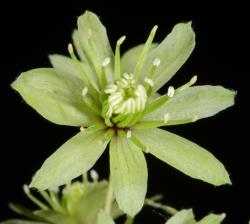- Taxon
- Gallery
- = Clematis hexapetala L.f., Suppl. Pl. 271 (1781)
- = Clematis hexapetala G.Forst., Fl. Ins. Austr. 42 (1786)
- = Clematis hexasepala DC., Syst. Nat. [Candolle] 1, 146 (1817)
- = Clematis colensoi Hook.f., Bot. Antarct. Voy. II. (Fl. Nov.-Zel.) Part I, 6, t. 1 (1852)
- = Clematis hexasepala var. rutifolia Hook.f., Bot. Antarct. Voy. II. (Fl. Nov.-Zel.) Part I, 7 (1852) – as rutaefolia
- ≡ Clematis colensoi var. rutifolia (Hook.f.) Hook.f., Handb. New Zealand Fl. 3 (1864) – as rutaefolia
- ≡ Clematis australis var. rutifolia (Hook.f.) Allan, Fl. New Zealand 1, 169 (1961) – as rutaefolia
- = Clematis australis Kirk, Stud. Fl. New Zealand 3 (1899)
- = Clematis hookeriana Allan, Fl. New Zealand 1, 169 (1961) nom. inval.
- = Clematis hookeriana var. lobulata Allan, Fl. New Zealand 1, 169 (1961) nom. inval.
Evergreen woody liane, usually climbing Over shrubs or small trees; dioecious. Stems up to 5 m long, 5-10 mm diam., ribbed and sparsely hairy when young, glabrous when mature, ascending or spreading. Leaves 3- foliolate, thin to coriaceous, green to grey-green. Leaflets 14-55 × 9-28 mm, simple to pinnate; simple leaflets lanceolate, broadly ovate or deltoid, entire, crenate, serrate or deeply pinnatifid to bipinnatisect; pinnae linear-oblong to broadly ovate; apices of leaflets, pinnae, crenations and serrations apiculate; bases attenuate to truncate, sometimes slightly cordate; petioles and petiolules 10-60 mm long, channelled, glabrous to sparsely hairy, twin- ing. Inflorescences axillary; flowers solitary, or 2- 10 clustered in leaf axils, or in dichasia1 cymes of 5-10; flowers unisexual, 10-45 mm diam. Pedicels 25-95 mm long, moderately to densely hairy; bracts 3-13(-18) × 14(-8) mm, inserted about middle of pedicel, usually linear to elliptic, occasionally broadly elliptic, connate, abaxial and adaxial surfaces ± glabrous to moderately hairy, apex acute to obtuse. Male flowers: sepals 5-6, 10.0-25.0 × 3.0- 13.0 mm, narrowly to broadly elliptic, lanceolate or ovate, cream, often flushed red-brown at base, abaxial and adaxial surfaces with moderate to dense pilose or villous hairs, rarely glabrous on the adaxial surface, apex subacute to obtuse; stamens 20-37; filaments 3-1 1 mm long, c. 0.9 mm wide, glabrous, linear, often tapering noticeably toward apex; anthers 2.4-3.5 mm long, 0.4-0.5 mm wide, linear-oblong, cream; receptacle 0.6-2.2 mm high, 1.4-2.2 mm wide, ± glabrous to moderately hairy; carpelodes absent. Female flowers: sepals 54(-7), 13.0-25.0 × 3.8-7.0 mm, narrowly elliptic to broadly elliptic, lanceolate to ovate, cream, often flushed red at base, abaxial and adaxial surfaces with moderate to dense pilose or villous hairs, apex subacute to obtuse; car- pels 35-48; ovary 0.5 × 0.2 mm, densely hairy; style 4-5 mm long; pappus hairs 5-6 mm long, dense, white, ascending; stigma 0.4-2.5 mm long, curved, papillate on adaxial surface, abaxial surface smooth; receptacle 1.8-2.3 mm high, 1.2-1.5 mm wide, moderately hairy; staminodes 1-6, in outer whorl; filaments 3.4-5.2 mm long: anthers c. I mm long, malformed, barren. Achenes 3.0-4.0 mm long, 1.4- 1.5 mm wide, 0.6-0.8 mm thick, sparsely to moderately hairy, dark brown to light brown, rarely red-brown; style 8-20 mm long, Pappus hairs spreading. FL SepMar; FT Oct-Apr.
[Reproduced from Heenan & Cartman (2000, New Zealand J. Bot. 38: 575-585) with permission from The Royal Society of New Zealand.]
Flowering: Sep.–Nov.; Fruiting: Nov.–Jan.




